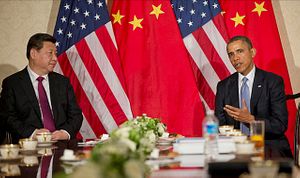The uneasy U.S.-China relationship as strategic partners and competitors was on full display at the recent APEC summit. Although encouraging, agreements on climate, trade, and maritime security cannot mask a fundamental geopolitical reality: The U.S. and China are locked in a great power competition, and their primary goals are incompatible. The U.S. wants to keep its seat at the head of the table in East Asia, and China wants to reclaim it. To achieve this goal, Chinese President Xi Jinping has taken a page out of the playbook of Mao Zedong: tightening the noose to test the U.S. commitment to its allies.
During the 1950s, Mao engineered two international crises in the Taiwan Strait by bombarding the nearby Jinmen islands. In both instances, he sought to dial up pressure on the U.S., or “tighten the noose,” by drawing attention to what he deemed its overextension and over-commitment to an island halfway around the world. In a speech at the Supreme State Council, Mao boasted, “At present, America has committed itself to an ‘all-round responsibility’ policy along our coast. Someday we will kick America, and it cannot run away, because it is tied up by our noose.” Ultimately, Mao’s noose strategy failed. He earned bragging rights for standing up to the U.S., but the Strait crises led to a security treaty between the U.S. and Taiwan, accelerated the Sino-Soviet split, and deepened China’s isolation.
Times have changed; China’s noose strategy has not. Now Xi has his hands on the rope. Since 2012, China has repeatedly challenged Japan’s control over the Senkaku/Diaoyu Islands by sending ships into its surrounding waters and declaring an ADIZ over the East China Sea. In the South China Sea, Xi has used a nine-dash noose to lasso the Scarborough Shoal and park an oil rig in Vietnamese waters. Beijing is once again probing the bottom line on the U.S. commitment to its allies. America proved it was not overcommitted against Mao’s weak China. But what about against Xi’s rising China?
For starters, consider Taiwan. The Chinese Communist Party has long identified Taiwan as a core national interest, and repeatedly pledged to use force to thwart any attempt to sever it from the mainland or impede reunification. As Peng Guangqian and Yao Youzhi, two prominent PLA generals, write, “The Taiwan issue is the largest and the last obstacle which we must conquer in the Chinese people’s path to rejuvenation in the 21st century, and it is by all means the most important in our national security strategy in this century.” Beijing leaves little room for doubt as to where Taiwan sits on its list of priorities.
Taiwan may not be at the bottom of the U.S. list of foreign policy priorities, but with foreign policy crises raging in Iraq, Syria and Ukraine, it is certainly not at the top. Most Americans would struggle to find Taiwan on a map, and the Taiwan Relations Act does not provide a security guarantee. In short, China may have good reason to doubt whether the U.S. is willing to pay any price and bear any burden for Taiwan.
In the East China Sea, Beijing harbors doubts about Washington’s willingness to go to war over an obscure group of rocks, especially when it takes no position on their sovereignty. However, any asymmetry of interests here is less pronounced. The islets are small, but the stakes are enormous. Abandonment of the U.S.-Japan Alliance would likely signal the end of U.S. regional – and global – hegemony.
The resurgent noose strategy is as much about testing the resolve of the U.S. as it is about demonstrating China’s resolve to recapture its rightful place in the world. National visions are powerful motivators. For the U.S., a national vision of liberal democracy and free markets has translated into permanent forward deployment of the U.S. military and the world’s largest alliance system. Underlying this forward strategy is the belief that liberal democracy is the best form of government, and that it must be protected at home and given to others when possible. This American vision is less than three centuries old; China’s view of itself as the center of the universe goes back thousands of years. As scholar Yan Xuetong notes, Chinese people believe China’s fall from preeminence to be “a historical mistake which they should correct.” If it is true that old habits die hard, the main tenets of China’s national vision are unlikely to change.
By pivoting to Asia, Washington is placing a bet that Beijing desperately wants to avoid a disastrous conflict as much as it does, and that the status quo in the region will endure. By tightening the noose, Beijing is trying to call its bluff. As Sun Tzu might observe, both sides are trying to win without fighting.
For now, that may be a viable strategy. But even if China continues its steady growth, avoids threatening its neighbors, and generally demonstrates that it is a responsible stakeholder in the international system, it is inconceivable that it would allow another superpower to have the best real estate in its own neighborhood. At some point, the U.S. and China’s national visions will collide. When that happens, Washington and Beijing will both have to make a monumental decision about the future of East Asia, and the rest of the world.
Zach Przystup received a master’s degree in international relations from The Fletcher School of Law and Diplomacy at Tufts University, where he studied U.S. Foreign Policy and Pacific Asia. He is now the Assistant Director for Global Executive and Diplomatic Education at The Fletcher School.
































